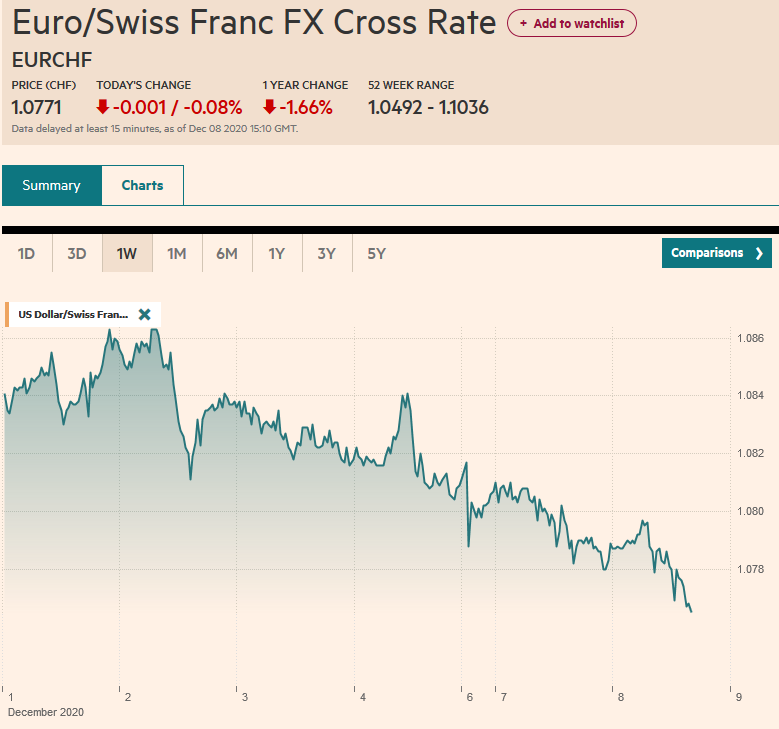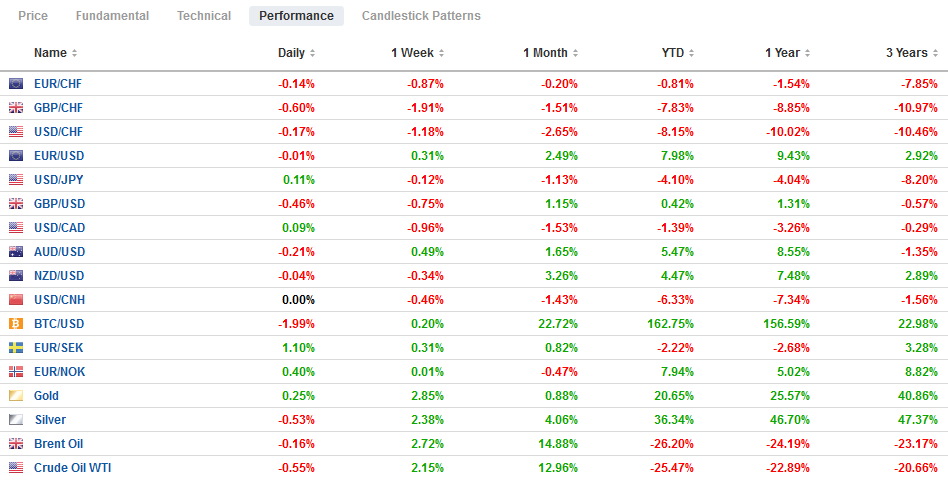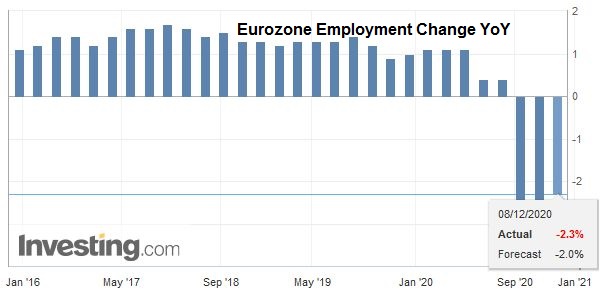Swiss FrancThe Euro has fallen by 0.08% to 1.0771 |
EUR/CHF and USD/CHF, December 8(see more posts on EUR/CHF, USD/CHF, ) Source: markets.ft.com - Click to enlarge |
FX RatesOverview: Three brinkmanship dramas continue to play out. The UK-EU trade talks have reportedly made little progress and may have even moved backward, according to some reports, over the past two days. The EU and Poland, and Hungary will be butting heads at the leaders’ summit that begins Thursday. The US federal spending authorization is exhausted at the end of the week. A maneuver to extend the deadline by a week appears in the works, but substantial differences remain. With equities falling in Japan, Hong Kong, China, and South Korea, the MSCI Asia Pacific Index fell for the second consecutive session for the first time since the end of October. Europe’s Dow Jones Stoxx 600 is also posting its second consecutive losing session. US shares are softer. Bond markets are also subdued, with the US 10-year benchmark around 0.93%, and yields are mostly a little lower in Europe. The greenback is mixed, with the euro, Swiss franc, and Canadian and Australian dollars and the euro enjoying small gains. Sterling is heavy but calmer than yesterday, and the Swedish krona is matching its decline (~0.3%). Thus far today, sterling is in around a quarter of a cent band on either side, $1.3350. The freely accessible emerging market currencies are mostly firmer, and the JP Morgan Emerging Market Currency Index is extending its advance for the fourth consecutive session to reach its best level since March. Today, the South African rand is the strongest among the emerging market currencies, helped by a stronger than expected Q3 GDP report (66.1% growth on a quarter-over-quarter basis, well above expectations for almost a 54.5% expansion). Gold extended its recovery to almost $1872 in Asia (November 30 low near $1765) following yesterday’s big outside up day. The momentum has flagged, and initial support is seen near $1860. Oil prices are little changed. The February WTI contract slipped to a three-day low near $45 and recovered to almost $46 and is little changed on the day. |
FX Performance, December 8 |
Asia Pacific
Japanese news dominates the region today, ahead of tomorrow’s release of Chinese inflation data. First, Japan’s Q3 GDP was revised higher. The 21.4% annualized pace initially reported was revised to 22.9%. On a quarter-over-quarter basis, this is a 5.3% growth instead of 5.0%. Business investment and consumption were stronger than initially anticipated. Second, the October high-frequency data were mixed. Labor cash earnings continue to fall. The 0.8% decline year-over-year in October was the seventh consecutive decline. On the other hand, household spending rose year-over-year for the first time since September 2019. However, the 1.9% increase was less than economists expected (2.8% was the median forecast in the Bloomberg survey).
Japan’s October current account surplus was in line with forecasts at JPY2.144 trillion. However, the trade surplus on a balance-of-payments basis was a little smaller than expected at JPY971 bln. It is still the largest monthly trade surplus since February and stood at JPY224 bln in October 2019. The capital account is notable. Trust accounts, which act for the pension funds, bought a record amount of foreign bonds in October (~JPY2.97 trillion) and sold a record amount of foreign equities (JPY2.52 trillion). Country-specific highlights include the purchases of a record amount of Canadian bonds. Japanese investors also were keen buyers of Australian and UK bonds, while sellers of French bonds.
Japan’s Prime Minister Suga unveiled a JPY73.6 trillion (~$710 bln) fiscal package that includes JPY40 trillion of new fiscal measures. The new efforts include funds for a new furlough program, health care expenditures, cash handouts, and funds for single-parent families. Almost half of the new fiscal measures will be paid for by already earmarked funds. The popular Go-To Travel, incentives for domestic tourism, which also dampens CPI, will be extended. Note that the BOJ meets next week and is expected to extend its current facilities deeper into 2021.
The dollar is in a tight range against the Japanese yen. It has not been below JPY103.95 or above JPY104.15. There is a $910 mln option at JPY104 that expires today, but its impact has likely been neutralized. In the somewhat larger picture, the greenback remains confined to a JPY103.65 to JPY104.75 range. The Australian dollar traded widely yesterday, on both sides of the ranges seen in the previous two sessions, but the close was neutral, and an inside day is being recorded. Options for around A$1.7 bln are struck at $0.7400-$0.7405 and expire today. The PBOC set the dollar’s reference rate at CNY6.5320, in line with expectations. The central bank injected liquidity into the banking system for the first time after conducting draining operations over the last five sessions. The dollar slipped to a new low for the move to about CNY6.5210 before recovering to almost back into Monday’s range (~CNY6.5295-CNY6.5440).
| Europe
Neither the UK nor the EU moved, and the same three issues that have vexed negotiators from the beginning remain unresolved. The mood has deteriorated. There will be a face-to-face meeting between Prime Minister Johnson and EC President von der Leyen in the next day or two. There has been some suggestion that Johnson talks to Merkel and Macron too. Indeed some have been critical that the Prime Minister has not done more in this vein. However, Johnson did signal that he is prepared to modify the Internal Markets bill that would unilaterally overrule the Withdrawal Bill and where the controversial parts were restored after the House of Lords diluted them. While Johnson’s stance was welcome, the move had already frayed nerves and patience while sowing distrust. Moreover, that strategy will be doubled down on with today’s introduction of the tax bill that is also seen unilaterally overriding the Withdrawal Agreement. |
Eurozone Gross Domestic Product (GDP) QoQ, Q3 2020(see more posts on Eurozone Gross Domestic Product, ) Source: investing.com - Click to enlarge |
| Germany’s ZEW investor survey captures both the seriousness of the economic consequences of the pandemic’s survey but also the optimism that the future is brighter. The current assessment deteriorated to -66.5 in December from -64.3 in November. This was a bit weaker than expected. On the other hand, the expectations component was stronger than anticipated at 55.0. It was a 39.0 in November. Separately, France reported a larger than expected improvement in the October trade balance. The shortfall of 4.85 bln euros was the smallest trade deficit since March. In the first ten months of the year, the average monthly deficit has been 5.85 bln euros. In the same period last year, the average trade shortfall was 4.89 bln euros. Germany reports its October trade figures tomorrow. Its average trade surplus through September was 14.3 bln euros (compared with 18.8 bln for the year-ago period). |
|
The euro slipped lower in the past two sessions but is slightly firmer today in a narrow range. It dipped briefly below $1.21 and has been capped in front of $1.2135. There is an expiring option for 1.7 bln euro at $1.21 and another for about 520 mln euros at $1.2150. The consolidative tone looks set to continue. Initial support is seen near $1.2080 and then $1.2040. The $1.2165-$1.2180 range may provide the near-term cap. Sterling covered a two-cent range yesterday (~$1.3325-$1.3435) and is considerably calmer today, trading in about a half a cent range (~$1.3325-$1.3380). It is stuck in a narrow range around $1.3350. The euro is firm against sterling near GBP0.9075, having seen GBP0.9140 yesterday. Here too, consolidation is likely as fresh developments are awaited.
America
Hope that an appropriations bill and measures can be combined and approved by the end of the week is fading. It was a tall order in any event, though it has seemed as if the tightness of the Georgia Senate races, the dramatic spread of the virus, and the disappointing employment report would have made a deal more likely. At the same time, President-elect Biden’s endorses of the bipartisan plan made Pelosi and Schumer more accommodative. Although bipartisan support for a $900 bln stimulus bill has grown, Senate GOP leader McConnell has yet to throw his support behind it, still seemingly preferring his previous $500 bln offer. Yet, disagreements about the funding for the border wall, bioenergy rules, and environmental protection, among other things, are proving nearly intractable. Several obstacles remain, including President Trump’s threat to veto the $740 bln defense bill if it does not eliminate social media companies’ protections for what is posted on their platforms. A short-term continuing resolution for the omnibus appropriations bill seems increasingly likely. However, there is no guarantee that an agreement will be reached, and the continued negotiations may further complicate the outlook for next week’s FOMC meeting.
Today is known in US election circles as safe harbor day. All of the disputes on the state level must be resolved. This makes possible next Monday’s meetings when each state’s electors vote. All of the electors’ votes must be received by December 23. The electoral votes are counted by Congress on January 6. A Biden nominates his top advisers, note happens at the Fed. Powell’s term as chair is up in early 2022. Ostensibly, he could remain a governor until 2028. Clarida’s position is a bit more complicated. His term as governor ends in early 2022, but his term as Vice-Chair does not end until September 2022. Quarles’s term as ViceChair of supervision ends next October, but he could remain a governor until early 2032. There is also the governor seat that Trump had nominated Sheldon that remains vacant. The takeaway is that the political drama is nearly over and that Biden will have a chance to remake the Fed if so inclined.
The North American economic calendar is light today, ahead of tomorrow’s Bank of Canada and Brazil Central Bank meetings. The US dollar has edged to a new two-year low against the Canadian dollar today, just below CAD1.2770. While there may be support around CAD1.2740, strong chart support is not seen until closer to CAD1.2500. Initial resistance is seen in the CAD1.2800-CAD1.2820 area. The dollar has been confined to yesterday’s range against the Mexican peso (~MXN19.7665-MXN19.9785). A close above MXN19.92, the week-old downtrend line, would suggest additional near-term consolidative that could see the dollar push back above MXN20.00. Last week’s high was in the MXN20.21-area.
Graphs and additional information on Swiss Franc by the snbchf team.
Full story here Are you the author? Previous post See more for Next postTags: #GBP,#USD,$AUD,$CAD,$CNY,$EUR,$JPY,Featured,MXN,newsletter
























